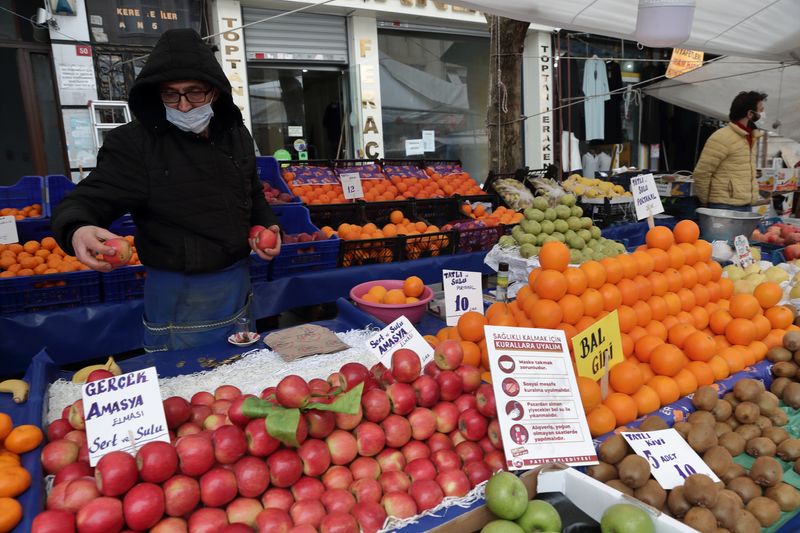Food inflation pain puts emerging markets between rock and hard place

© Reuters. FILE PHOTO: Seref Geyik, a 53-year old seller, waits for customers at his stall at a local market in Fatih district in Istanbul, Turkey January 13, 2021. REUTERS/Murad Sezer
2/2
By Karin Strohecker, Ezgi Erkoyun and Sarah El Safty
LONDON/ISTANBUL/CAIRO (Reuters) – Like for millions of people in developing and emerging market countries around the world, shopping for staple foods has turned from a necessity into a luxury for Selcuk Gemici.
The 49-year-old, who works in an auto repair shop in Turkey’s largest city Istanbul and lives with his wife and two children in his father’s house, says fresh produce is often out of reach with his family living on pasta, bulgur and beans.
“Everything became so expensive, we cannot buy and eat what we want – we only buy what we can afford now,” said Gemici. “My children are not properly nourished.”
Global food prices have climbed for two years, fuelled by COVID-19 disruptions and weather woes. Supply shocks to grains and oils from Russia’s invasion of Ukraine saw them hit an all-time record in February, and again in March.
Inflation rates have soared, with energy price rises adding to pressure. Turkey or Argentina with annual inflation of 70% and around 60% might be outliers, but readings are into double-digits in countries from Brazil to Hungary. It makes U.S. inflation at 8.3% look modest in comparison.
Rising food prices are a hot topic in emerging market, raising the risk of civil unrest with echoes of the Arab spring and putting policy makers in a bind between stepping in with fiscal support to ease the pain on their population or preserve government finances.
Food is the single largest category in inflation baskets – the selection of goods used to calculate the cost of living – in many developing nations, accounting for around half in countries like India or Pakistan and on average for some 40% in low-income countries, International Monetary Fund data shows.
Food producers have become more protective: India on the weekend announcing a ban on wheat exports while Indonesia halted exports of palm oil to control soaring prices at home in late April.
Soaring wheat and rising food prices fuel inflation https://fingfx.thomsonreuters.com/gfx/mkt/klvykoeqwvg/Soaring%20wheat%20and%20rising%20food%20prices%20fuel%20inflation.PNG
And with the war in Ukraine not only disrupting food but also fertilizer supplies, food inflation could be more longer-lasting, Marcelo Carvalho, head of global emerging markets research at BNP Paribas (OTC:) told Reuters.
“This is here to stay,” said Carvalho. “Food is very salient – when there is a change in food prices, the perception about inflation is magnified – that feeds into inflation expectations that are more easily unanchored.”
HOT SPOT
For Um Ibrahim, a 60-year-old widow and street vendor selling headscarves in front of a mosque in the middle-class district of Madinet Nasr in Egypt’s capital Cairo, feeding her four children has become much harder.
…
Read More: Food inflation pain puts emerging markets between rock and hard place
